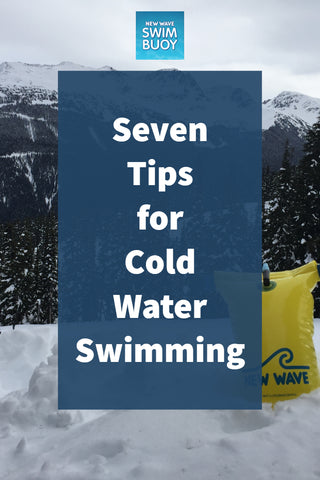Brrrr. A chilly spring means temperatures at your favourite open water swimming venues are colder than usual this year. But these tips to help you handle the cold will get you back to open water swimming.
Save diving in for warmer waters! When it's cold, ease yourself in to reduce the shock
- Cold Showers
You won’t like this bit of advice but it’s the simplest thing you can do to prepare your body for cold water. Look at it this way it's the one bit of training which will save you time instead of cost you time (trust me, time spent in the bathroom each morning will dramatically drop!).
For a few weeks before your swim, take cold showers or baths to familiarise yourself with the sensation. The first splashdown into cold water can be a physical and psychological shock but if your body is acclimatised you won’t get such a sudden increase in heart rate and adrenaline, which can cause you to hyperventilate in the water.
- The Right Wetsuit
Neoprene insulates your body against cold temperatures, helps your muscles and joints work efficiently and improves buoyancy to keep your body position high in the water. Not only does this help you swim faster but it means you can take rests without expending energy trying to stay at the surface.
1, 2 and 3 mm suits are good for water temperatures of 18˚C and above, but you’ll need a wetsuit that’s 4, 5 or 6mm thick, with sealed and taped seams to help maintain body heat in colder waters, particularly coastal swims.
The thickest wetsuits can lack flexibility so look for those which have in-built panels to support full range of movement. It should feel snug, particularly around the torso, neck, wrists and ankles.
However, the snugger the fit, the trickier they are to get on and off and can cause chaffing so get out the BodyGlide. Avoid petroleum based lubricants because they can rot the neoprene. Just remember to wash your hands before touching your goggles!
Make sure you have the right thickness of wetsuit for the typical temperatures you'll be swimming in
- Warm Up
Warming up is important for any training, but particularly so for cold water swimming. It will open up your capillaries to get lots of warm blood flowing around your body and bring up your heart rate slowly, reducing the impact of the unavoidable shock you’ll experience entering cold water.
Warming up also delivers oxygen to your muscles to loosen them up for full range of motion and if you are warm it will help trap a layer of heat inside your wetsuit, insulating you against the cold.
Stretch and jog on the spot if you have to, to increase your heart rate and get the blood pumping.
- Wade In
First contact with cold water will be the shock moment. Your body’s natural response will be an involuntary gasp and you’ll experience some initial shortness of breath so never jump or dive in. Keeping your head above the surface will help prevent inhaling any water into your lungs.
Wade or lower yourself into the water from the bank or shore slowly and then start keep moving. If you linger to assess the cold or admire the view, you’re wasting body heat and energy.
However, dip your face in the water a few times before you start swimming properly so you can absorb the shock before you do anything aerobic.
Breathlessness can be frightening but don’t panic, it’s normal and will pass within a minute or so.
However, another natural response to immersion in cold water can be the constriction of your arteries. This forces your heart to work harder to deliver oxygen to your major organs and muscles and in the worst case scenario, can cause cardiac shock as cooled blood reaches the heart.
If you have a heart condition or asthma, seek advice from your GP before attempting cold water swims.
- Build Strength Slowly
You may be able to comfortably swim 10km in the pool, but cold water combined with any swell or currents demand more energy and can quickly sap your strength.
Cold water draws heat away from your body 25 times faster than cold air of the same temperature. As your body tries to recover that heat, it forces your heart and respiratory system to work harder, causing you to tire more quickly.
Don’t push yourself too hard by trying to swim for the same distance or duration that you can in the pool. Begin with short, cold water swims of just a few minutes in the shallows or aim for a marker such as a rock, tree or buoy and increase the length or duration slowly.
Tempted yet? Don't be ashamed of starting with 10 minute swims to acclimatise
- Know Your Limits
One of the biggest risks for outdoor swimmers is hypothermia and no swimmer, regardless how strong or experienced they are, is immune, so know the signs.
Initially you’ll feel cold but within a minute or two of swimming, this should abate. However, if you start to feel colder as you swim, if your muscles feel fatigued or stiff, you feel confused, your breathing is affected or if you feel shivery and unusually tired, get out immediately. Learn to spot the signs in others too. Pale skin, drowsiness or slurred speech are not good signs!
Symptoms can develop quickly so swim close to the shoreline and have towels and dry clothes nearby.
- Recover
When you get out of the water, your core temperature will continue to decline.
Avoid the temptation to get straight into a hot bath or shower as this can make blood vessels open too quickly, causing a sudden drop in blood pressure that can result in poor circulation for major organs and increase your risk of anything from fainting to cardiac arrest.
Instead, get dried and dress immediately in warm layers, have a warm drink and keep moving to regain your regular body temperature safely. Then just wallow in all the lovely endorphins your swim has produced!

